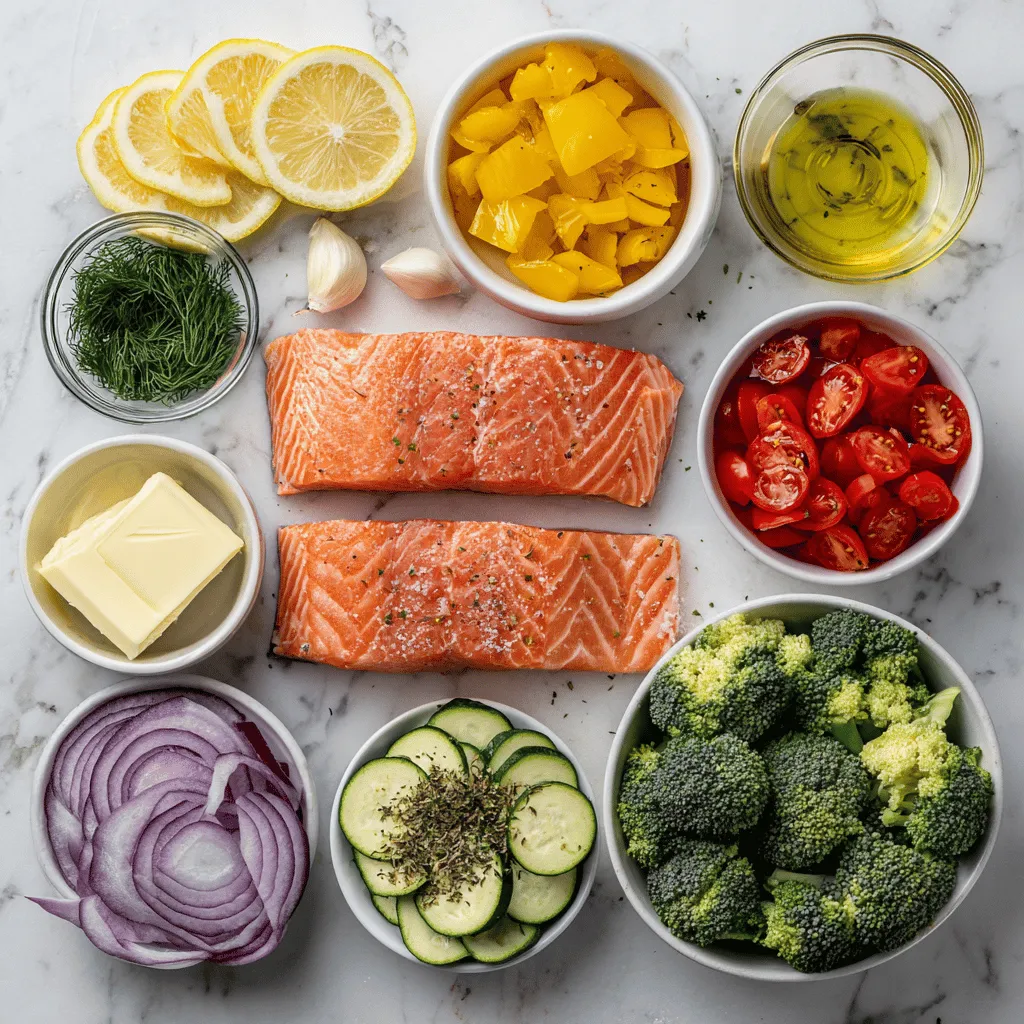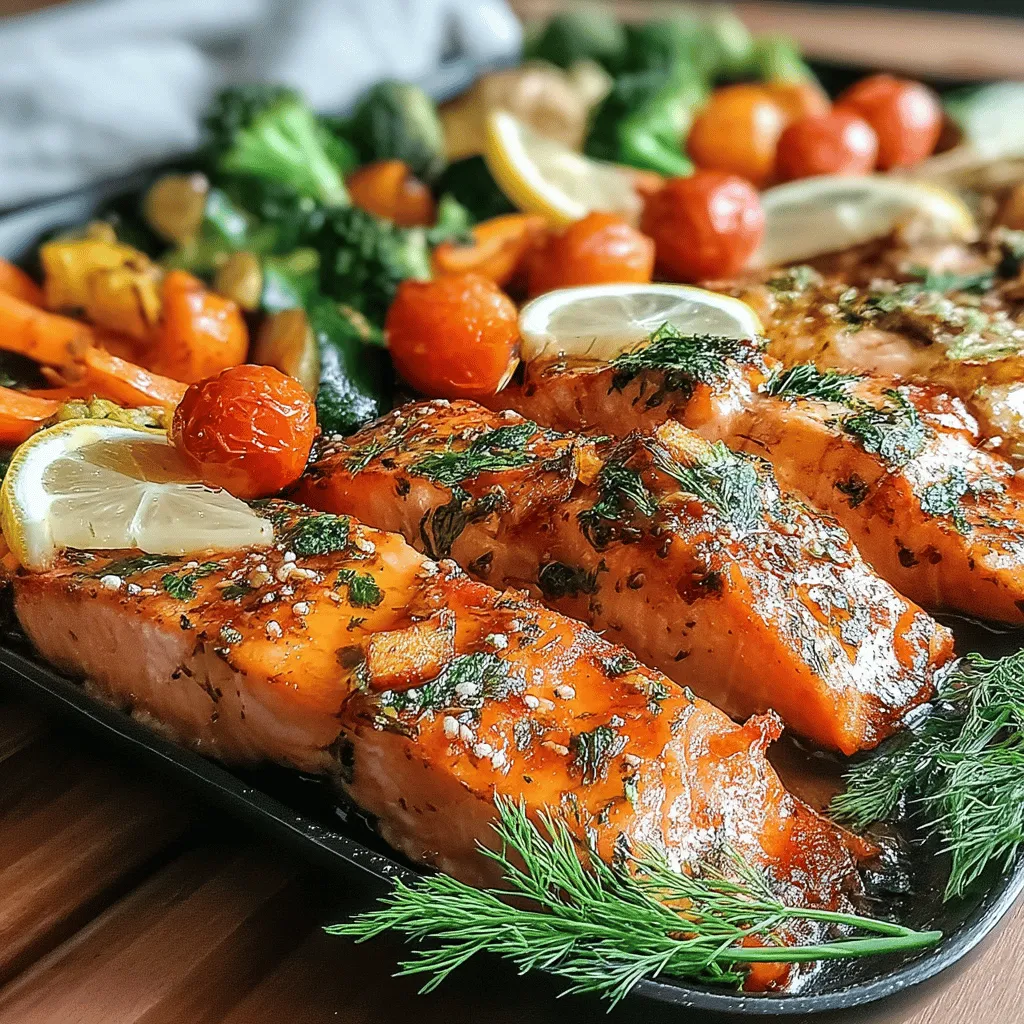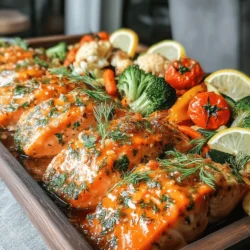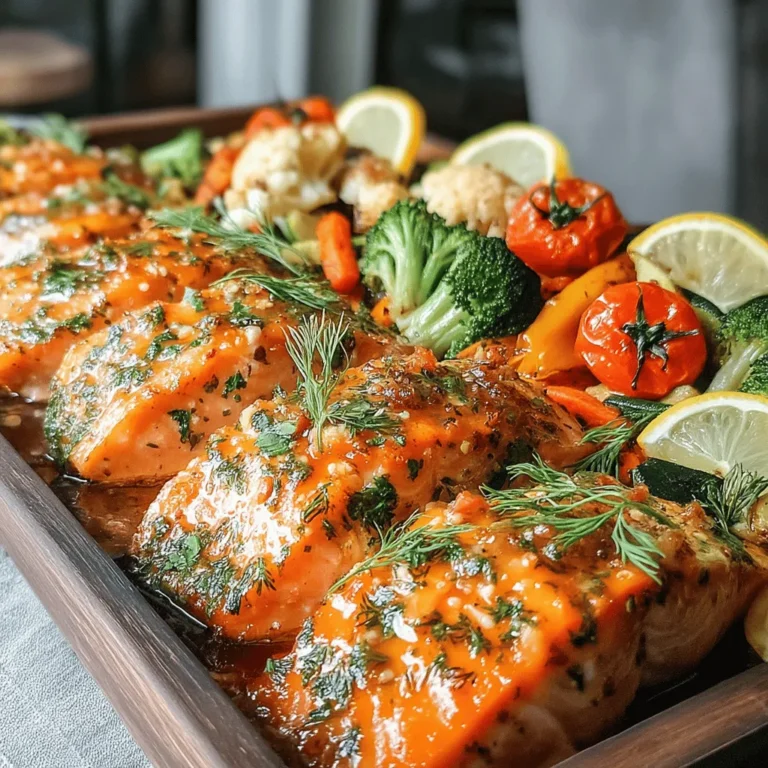Introduction
Dive into a delightful culinary experience with our Buttery Dill Delight Salmon paired with vibrant rainbow roasted veggies. This dish not only tantalizes your taste buds with its rich flavors but also presents a feast for the eyes. Discover how to create this nutritious meal that combines the heartiness of salmon with the freshness of seasonal vegetables, making it perfect for a weeknight dinner or a special occasion.
The combination of buttery salmon infused with dill and a medley of colorful roasted veggies creates a wholesome yet indulgent meal. As you prepare this dish, you’ll not only enjoy the cooking process but also the delightful aroma that fills your kitchen. Let’s embark on this culinary journey and learn how to make a dish that is sure to impress!
Recipe Overview
– Total Time: 30 minutes
– Servings: 4
– Difficulty: Easy
Ingredients
– 4 salmon fillets
– 1/4 cup unsalted butter
– 2 tablespoons fresh dill, chopped
– 3 cloves garlic, minced
– 1 cup cherry tomatoes, halved
– 1 bell pepper, sliced
– 1 zucchini, sliced
– 1 cup asparagus, trimmed
– Olive oil
– Salt and pepper to taste
– Lemon wedges for serving

Instructions
1. Preheat your oven to 400°F (200°C).
2. Line a baking sheet with parchment paper.
3. In a small saucepan, melt the butter over low heat, then stir in the chopped dill and minced garlic. Set aside.
4. Arrange the salmon fillets in the center of the prepared baking sheet.
5. Surround the salmon with the cherry tomatoes, bell pepper, zucchini, and asparagus.
6. Drizzle olive oil over the veggies and season with salt and pepper.
7. Pour the dill-butter sauce over the salmon fillets evenly.
8. Bake in the preheated oven for 15-20 minutes or until the salmon is cooked through and the vegetables are tender.
9. Serve hot with lemon wedges on the side.
Understanding the Ingredients
The Star of the Dish: Salmon
– Nutritional Benefits of Salmon
– Different Types of Salmon: Wild vs. Farmed
– Selecting the Best Salmon Fillets
Flavor Enhancers: Dill and Garlic
– The Role of Fresh Herbs in Cooking
– Health Benefits of Dill
– How Garlic Elevates Flavor Profiles
Colorful and Nutritious Veggies
– Overview of the Chosen Vegetables
– Nutritional Value of Each Vegetable
– Seasonal Considerations for Fresh Ingredients

How to Choose Fresh, Quality Vegetables
Selecting the right vegetables is crucial for achieving the best flavor and texture in your dish. Look for vegetables that are vibrant in color, firm to the touch, and free from blemishes or soft spots. Seasonal vegetables will not only be fresher but also more affordable. Always aim for organic produce when possible to avoid pesticides and enhance the dish’s overall quality.
Chopping Techniques for Even Cooking
Seasoning and Roasting Techniques
Proper chopping is essential for even cooking. Cut your vegetables into uniform sizes, typically about 1-inch pieces. This ensures that they roast at the same rate, preventing some from becoming overcooked while others remain underdone. For root vegetables, consider cutting them slightly smaller, as they tend to take longer to cook.
Best Practices for Tossing Veggies in Oil and Seasoning
When preparing your vegetables for roasting, toss them in a bowl with olive oil and your chosen seasonings. Use enough oil to coat the vegetables lightly but avoid soaking them. A good rule of thumb is about one tablespoon of oil per cup of vegetables. Season with salt, pepper, and herbs to enhance their natural flavors.
How to Achieve Perfect Roasting: Temperature and Timing
Preheat your oven to 425°F (220°C) for optimal roasting. This high temperature will help caramelize the natural sugars in the vegetables, creating a deliciously crispy exterior. Roast your veggies for 20-30 minutes, ensuring to stir them halfway through for even browning.
The Science Behind Roasting Vegetables
Roasting vegetables not only enhances their flavor but also increases their nutrient availability. The high heat causes the Maillard reaction, which brings out the natural sweetness and depth of flavor while reducing moisture content. This process also helps to release antioxidants, making your meal both tasty and nutritious.
Bringing It All Together: Cooking Process
Combining Salmon and Veggies
Arrangement Tips for Even Cooking
When placing your salmon and vegetables on the baking sheet, ensure that they are spaced evenly. This allows hot air to circulate around each piece, promoting even cooking. Place the salmon in the center of the tray and arrange the vegetables around it for a visually appealing presentation and optimal heat distribution.
Understanding Cooking Times for Optimal Results
Typically, salmon fillets will require about 12-15 minutes to cook through, depending on their thickness. When planning your cooking times, consider that vegetables may need a bit longer, so start roasting them first for about 10 minutes before adding the salmon.
Monitoring the Roasting Process
Signs That Your Salmon and Veggies Are Done
Your salmon is perfectly cooked when it flakes easily with a fork and has an internal temperature of 145°F (63°C). For vegetables, look for a golden brown color and a tender texture, which indicates they are ready to be served.
Adjusting Cooking Times Based on Oven Variability
Ovens can vary greatly in temperature accuracy. If you notice your cooking times are consistently off, consider using an oven thermometer to ensure your oven is heating correctly. Adjust cooking times as needed based on your observations for the best results.
Presentation and Serving Suggestions
Creating a Visually Appealing Plate
Techniques for Plating Salmon and Veggies
To create a stunning plate, start by placing the salmon in the center, then artfully arrange the roasted vegetables around it. Use contrasting colors to create a vibrant look, and consider stacking the veggies for height.
Importance of Garnishing with Fresh Herbs and Citrus
A sprinkle of freshly chopped dill or parsley adds a pop of color and freshness to your dish. A wedge of lemon or lime served on the side not only enhances the presentation but also allows guests to brighten the flavors to their liking.
Pairing Suggestions
Ideal Side Dishes to Complement the Meal
Consider serving your salmon and veggies with a side of quinoa or a simple green salad to enhance the meal’s nutritional value. A light couscous or a grain pilaf can also provide a satisfying contrast to the dish.
Beverage Pairings: Wine, Water, or Mocktails
Light white wines, such as Sauvignon Blanc or Pinot Grigio, pair beautifully with salmon and enhance the overall dining experience. For non-alcoholic options, serve sparkling water with a slice of citrus or a refreshing mocktail made with fresh herbs and fruit.
Nutritional Information
Healthy Aspects of This Dish
Breakdown of Calories, Proteins, and Fats
This dish is not only delicious but also packed with nutrients. A serving of Buttery Dill Delight Salmon contains approximately 350 calories, 30 grams of protein, and 20 grams of healthy fats, making it a balanced meal option.
Benefits of Incorporating Fish and Vegetables into Your Diet
Eating fish, particularly salmon, is associated with numerous health benefits due to its high omega-3 fatty acid content, which supports heart health and reduces inflammation. Combining fish with a variety of colorful vegetables provides essential vitamins, minerals, and antioxidants, making this dish both delicious and nutritious.
Conclusion
The Buttery Dill Delight Salmon accompanied by rainbow roasted veggies is more than just a meal; it’s a celebration of flavors, colors, and nutrition. By following the steps outlined in this guide, you can create a dish that not only satisfies your appetite but also nourishes your body. Embrace this recipe for its simplicity and elegance, making it a staple in your culinary repertoire. Enjoy the delightful combination of textures and flavors that will leave you and your loved ones asking for seconds.


